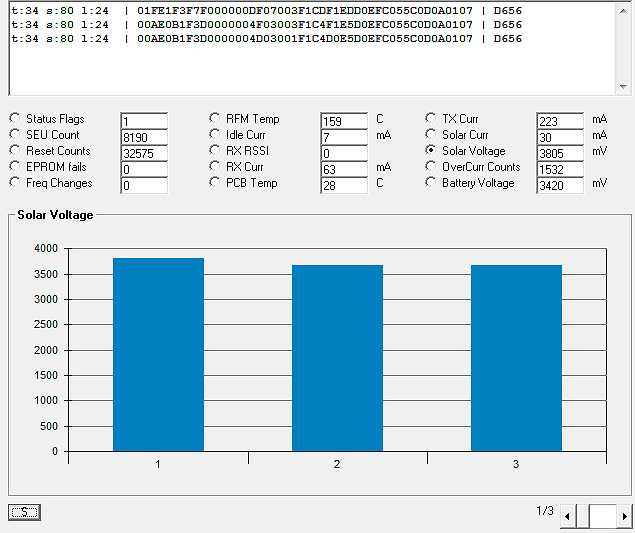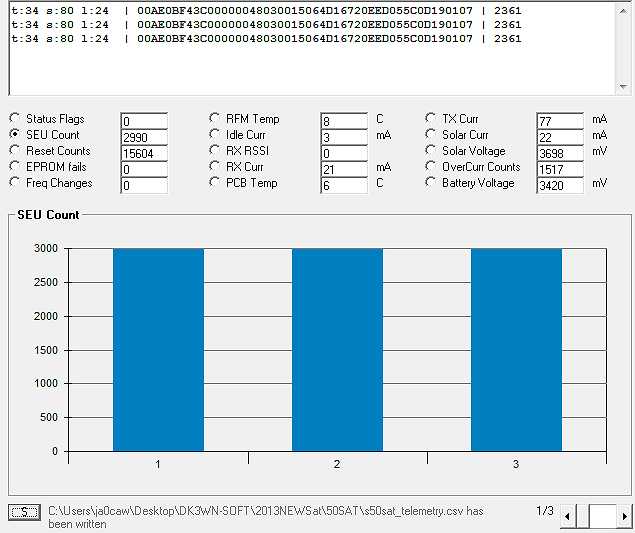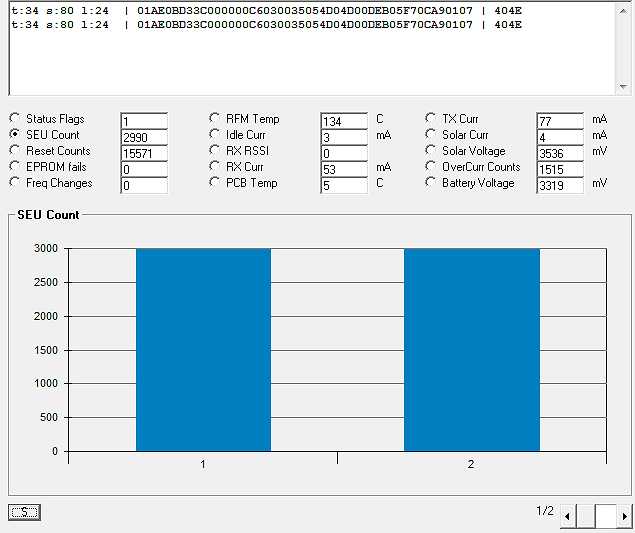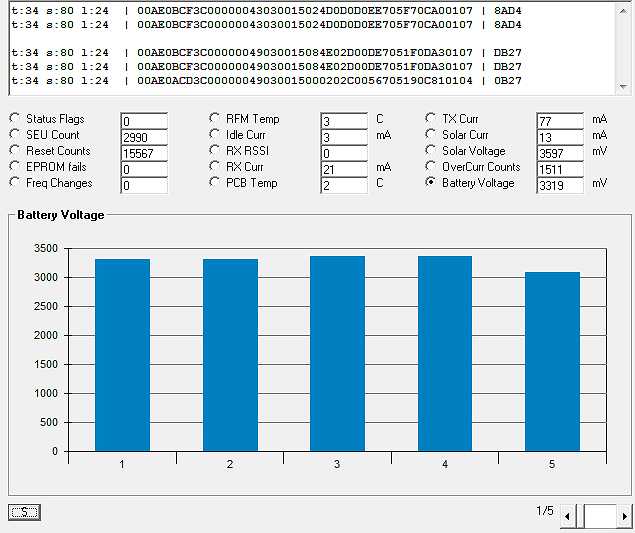DECAY_EPOCH WINDOW REV DIRECTION LAT LON INCL NEXT_REPORT 2018-05-18 19:37:00 120 24876 ascending -63.9 121.2 97.7 0 2018-05-18 19:37:00 120 24876 ascending -64.8 121.8 97.7 0 2018-05-18 19:36:00 120 24876 ascending -68.7 125.6 97.7 2 2018-05-18 19:20:00 180 24877 descending -45.1 281.8 97.7 6 2018-05-18 21:25:00 360 24879 ascending 11.6 76.8 97.7 12 2018-05-19 00:07:00 540 24879 ascending -48.9 46.6 97.7 24 2018-05-18 20:54:00 900 24877 descending -73.6 238.9 97.7 48 2018-05-18 20:09:00 1140 24877 ascending 74.1 69.2 97.7 72
Category: $50SAT
MOREHEAD OSCAR 76 ($50SAT) decay prediction

http://www.dk3wn.info/sat/afu/sat_s50sat.shtml
$50SAT Falls Silent
Tuesday, July 21, 2015 marked the 20 month anniversary of the launch of $50SAT/MO-76/Eagle2, and unfortunately, it appears to have gone silent. The last time I heard it was on Sunday, July 19, 2015, 08:42 UTC from Anton’s (ZR6AIC) WebSDR. A screenshot of the WebSDR while $50SAT was transmitting RTTY, a screenshot of gpredict showing its location during the transmission, and the captured RTTY audio are up on the Dropbox; they are accessible via the following URL:
https://www.dropbox.com/sh/l3919wtfiywk2gf/AAD6Q3gJYziGVwavQ1OkSxAia/Latest-Observation
Unfortunately, there was a fade starting in the middle of the capture, so I was only able to do a partial decode:
2015-07-19,08:42,KG43,ZR6AIC/KD8QBA,$50SAT,,2990,15719,,,84,3,,22,?,?,?,?,?,?,*? (NO CHECKSUM – MISSING DATA)
Has anyone else has heard $50SAT since July 19? If so, please let us know.
The likely cause of failure was a near complete loss of solar power. Looking at the last 5 complete RTTY telemetry messages, the amount of solar power being generated was very low:
2015-06-21,08:23,KG43,ZR6AIC/KD8QBA,$50SAT,,2990,15688,,,82,3,,22,16,78,,3435,1572,3319,*4A (3435 mV, 0 mA, 0 mW)
2015-06-22,08:15,KG43,ZR6AIC/KD8QBA,$50SAT,,2990,15689,,,81,3,,21,15,78,4,3536,1573,3339,*7D (3536 mV, 4 mA, 14 mW)
2015-06-22,08:20,KG43,ZR6AIC/KD8QBA,$50SAT,,2990,15689,,,84,3,,22,17,78,3,3556,1573,3339,*78 (3556 mV, 3 mA, 11 mW)
2015-07-07,08:25,KG43,ZR6AIC/KD8QBA,$50SAT,,2990,15706,,,84,3,,22,18,78,1,3475,1590,3319,*7C (3475 mV, 1 mA, 3 mW)
2015-07-09,08:07,KG43,ZR6AIC/KD8QBA,$50SAT,,2990,15708,,,81,3,,22,15,78,3,3516,1592,3319,*7E (3516 mV, 3 mA, 11 mW)
Moreover, when looking at the Battery Voltage/MPPT Current chart, the last set of MPPT (solar) current measurements are well below the trendline, which itself has a negative slope:
https://www.dropbox.com/sh/l3919wtfiywk2gf/AABKSR5V4cOvEPqPYbs8QYZNa/Telemetry-analysis/Current-Telemetry/Battery-Voltage-MPPT-Current-Chart.pdf
Because $50SAT will not transmit if the battery voltage is below 3300 mV, we do not know if it is completely dead or the battery voltage is almost always too low to enable the transmitter.
Our best guess as to what happened is the solar cells have been slowly damaged due to sputtering. All the high energy particles from the solar wind can effectively “sandblast” the satellite, and since our cells had no protective cover glass, this will cause the surface to slowly become diffused, and thus cause the output of the cells to drop. We knew this would happen. What we did not know is $50SAT would operate long enough where this would become a problem; our bets were on the battery failing first. Since many other CubeSats used the same Spectrolab TASC cells as we did, we are curious about how long it took for the solar output to degrade on these other satellites. If any of them are reading this post, we would love to hear from you!
We are now in the “how long will it stay in orbit?” phase of the mission. Thanks to James DeYoung, N8OQ, we have a de-orbit prediction of May of 2017. From July 6, 2015 to August 28, 2015, the orbital decay rate was about 0.79 km/week. Earlier this year, it was about 1.2 km/week. As of August 28, 2015, apogee was at 554 km, and perigee was at 525 km. We will continue to monitor the TLEs from Celestrak and periodically update the “Orbital-Analysis” folder on the Dropbox.
We would like to extend a very big THANK YOU to the worldwide amateur satellite community! You helped make our mission a resounding success! We were able to determine it was possible to make a satellite this small which could generate and store its own power as well as have two-way radio communication capability. We were able to do this using commercially available parts, including a $10 Li-Ion camera battery, a $10 ISM band radio, and a microcontroller programmed in interpreted BASIC. We look forward to seeing what the next generation of PocketQubes can do.
73
The $50SAT/MO-76/Eagle-2 team:
Howie DeFelice, AB2S
Stuart Robinson, GW7HPW
Michael Kirkhart, KD8QBA
Professor Robert Twiggs, KE6QMD
$50Sat telemetry
$50Sat telemetry
$50SAT RTTY Telemetry
08:48 UTC $$50SAT,,2990,15601,,,65,3,,21,,77,14,361----------
$50Sat telemetry
$50sat update
Tuesday, April 21, 2015 marked the 17 month anniversary of the launch of $50SAT/MO-76/Eagle-2, and believe or not, it is still operating.
Unfortunately, the battery capacity has degraded to the point where the satellite spends a significant amount of time with the battery voltage below
the 3300 mV minimum required for enabling the transmitter. As a result, those of us who live in the northern hemisphere no longer hear any
transmissions during the evening passes, and for now, rarely hear any during the daytime passes as well. The last telemetry packet I captured here in
EN82 land was April 21, and the last one which was error-free on April 10. Fortunately, I have been able hear it operate over Anton’s (ZR6AIC) WebSDR station in South Africa during the evening passes (which occur between 4:00 and 6:00 PM Eastern Daylight Time), and occasionally am able to capture error-free telemetry packets. The last one available is from April 24 at 21:25 UTC.

This situation was fully expected; when looking at the battery voltage chart (which, along with all the other telemetry, is available from our Dropbox, the readings took a large drop sometime after February 12. Given this was a $10 camera battery that had gone through over 6,000 orbits, each with temperature swings of -30 degrees C to +30 degrees C, it is surprising it has lasted this long! At this point, it is starting to behave more like a large capacitor than a battery.

As we get closer to summer here in the northern hemisphere (and after this winter, it cannot come soon enough), $50SAT/MO-76/Eagle-2 will spend more
time in the sun before it makes each pass; this means it will be warm enough to enable solar power sooner in the pass, and makes it more likely it we
will be able to hear it transmit before it disappears over the southern horizon. Those of you who live in the southern hemisphere, however, should
still be able to hear it during both daytime and evening passes. If you could, we would certainly appreciate any telemetry you could gather and
post. In the meantime, I will continue to update the Dropbox with any new telemetry gathered. Please keep it coming, even if it has errors or is
incomplete. At this point, we are happy to simply know that it is still operating.
Michael Kirkhart, KD8QBA
$50SAT/MO-76/Eagle-2 team





